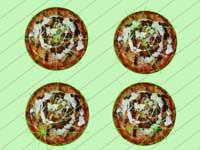The equality standard in a pizza

Two American mathematicians, one from the Louisiana State University and one from the Missouri State University of the Southeast, have recently demonstrated in what cases and in what situation the pizza distribution is the same for both diners and in which cases it is not. Yes, they have spent about fifteen years doing exams (and eating pizzas) to draw the conclusions they have drawn now.
In the pizzerias or other restaurants, the pizzas are divided into pieces and, of course, having to walk in a hurry, not much attention is paid to the courts. And when customers receive it they see that some parts are bigger than others, and well, after all, not everyone will eat the same thing.
This is not usually a problem for the general public, it has no other importance. For mathematicians, however, the issue of distribution is a great challenge. And in fact it has become. The two mathematicians have responded after fifteen years, but, as they have said in the article published in the journal American Mathematical Monthly, the problem they have clarified was raised 40 years ago.

In these four pizzas you can see how a pizza can be cut (Photo: Per Ola Wiberg).
Sometimes yes, others do not
In the proposed solution, one of the premises is that there are two people who eat a pizza; another premise is that they receive the slices of pizza alternatively; and the third, that the angles of all parts, or thicknesses, are equal. From there, four possible situations are proposed. We will see them from the easiest to the most difficult.
A possible situation is that the cuts pass through the middle point of the pizza. Just like all the cuts pass through the center, or that only one of them is the one that crosses the central point; both in one and the other, with the number of cuts that are made, the two will eat the same amount of pizza.
But what happens in cases where no court crosses the central point? Well, when the number of cuts is even (when making two cuts the pizza is divided into four parts; when making four, in eight, etc. ), two people will continue to eat the same amount, as long as they take the parts by turns.

As the pizza is divided, diners can eat or not the same amount of pizza. (Photo: Photoxpress_Monique Pouzet).
When the number of cuts is odd you can not eat the same amount of pizza. But two situations can be distinguished. On the one hand, when three cuts are made, that is, by dividing the pizza into six fractions, who eats the pizza part with the middle point of the pizza will eat more pizza than the rest. And, instead, by making five cuts and dividing the pizza into ten fractions, who eats the part with the central point will eat less than the rest.
The next odd cut would be seven. Because the situation of seven courts would be similar to that of three. The next, the ninth, would be the fifth; lunch, again, triple, etc.
What things to know about pizzas and how to cut them! The activities of daily life are filled with this kind of curiosities… What looks look like! The next time you go to eat pizza, if you want to comply with what the saying says "whoever divides the cake saves the best part", you should consider it!
Published in 7K.
Buletina
Bidali zure helbide elektronikoa eta jaso asteroko buletina zure sarrera-ontzian











